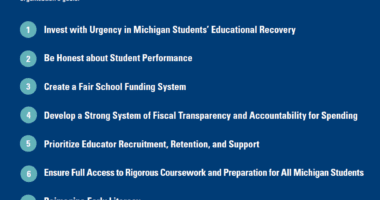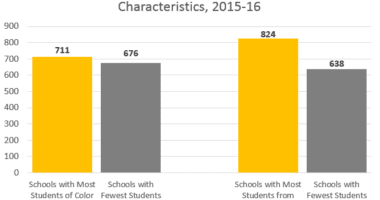Detroit’s Educational Catastrophe
Three months into her son’s first pass at third grade, Arlyssa Heard had a breakdown. Judah was bright, but had begun calling himself stupid. The chaos of Detroit’s precarious education landscape had forced him to switch schools every few months, leaving him further and further behind.
There was no central system to transfer Judah’s records when he moved, and according to Heard the school where he started the 2014-15 academic year had a single teacher assigned to 44 third-graders. Heard was virtually alone in trying to deal with the fact that her boy, then 8, could write only the first two letters of his name.
Heard says she was one of the parents Detroit Public Schools turned to when it needed a strong family showing at a rally or community members to serve on a task force. She was running for the Detroit School Board. But when she needed help, she had nowhere to turn.
“Here I was this advocate for education, and I couldn’t find a place for my son,” she says. “I was crying in the principal’s office and I said, ‘I don’t know what to do.’ The principal said, ‘I don’t either.’”
The scope of the problems plaguing Detroit schools—both traditional district schools and charters—is almost unfathomable. According to the most recent National Assessment of Educational Progress, only 4 percent of Detroit’s eighth-grade students can read and perform math at grade level, the lowest rate among the nation’s big cities. Schools aren’t located where families need them, and campuses often open and close with no coordination or notice. Over the last six years, most schools in the city have either opened or closed—or both. In one neighborhood in the city’s southwest quadrant, home to a large Latino population and a number of industrial zones, a dozen schools opened or closed in the span of 18 months. And when a parent shows up to find a child’s classroom abandoned, good luck finding a new one. There are more than 200 schools with roughly 50 different enrollment processes and almost no standard for performance.
Now, Detroit Public Schools are so far in the red it might not be able to pay teachers through the end of the school year, and two bills are moving through the Michigan legislature aimed at preventing a financial catastrophe. The version passed by the House of Representatives in the early hours of May 5 includes $500 million in debt relief for the district, which would remain under state control. The bill would also impose restrictions on teachers’ ability to bargain contracts and outlaw the strikes over crumbling buildings, among other provisions. Meanwhile, in March the state Senate passed a bill favored by Detroit lawmakers that would return control of the schools to the local, elected school board and create a Detroit Education Commission with the authority to make decisions on things like school closures and minimum acceptable outcomes for charter schools. A conference committee will now attempt to reconcile the radically different bills.
Heard was part of the group that drafted the recommendations on which the Senate bill is based. As the political process unfolded, she’s become a citizen lobbyist, driving parents to the Capitol to explain to lawmakers why they should abandon the policies she believes have driven the school systems’ rapid decline. “Families here are beat down and bitter,” says Heard. “I should be going to parent-teacher conferences and volunteering at the school as much as I can. But instead I’m driving back and forth to Lansing.” Heard and her fellow parents want the legislature to approve the Senate bill on the grounds that it would enable an entirely new system of oversight and drive quality. No one knows whether it will work—there hasn’t ever been anything like it.
But then again, the country has probably never witnessed an education crisis quite like Detroit’s.
Inside a church on Detroit’s East Side, Mayor Mike Duggan faces a crowd of hardened skeptics. It’s been a generation since an elected official delivered in this city in any meaningful way, but the mayor has shown up with a PowerPoint laying out precisely what his 2-year-old administration has done since he took office in 2014.
After clicking through slides mapping new streetlights, foreclosed homes, and the teardown of crumbling buildings, he finally gets to abandoned schools, which he calls “one of the worst contributors to the blight.” Since the state first took over the city’s schools in 1999, almost 200 Detroit Public Schools buildings have closed; 81 sit vacant.
If they think about Detroit at all, most people likely imagine a city in inexorable decline caused by the collapse of its auto industry. But the roots of the problems confronting its schools actually go back further—to 1966, when enrollment peaked at close to 300,000 students and white flight began. And as Duggan highlighted, there’s also another, much more recent backstory to the current crisis: the state-appointed emergency managers who seized control of Detroit Public Schools in 1999 and ran the district for all but several of the years since then.
Some 20 states have laws allowing the governor to appoint an emergency manager to take over a financially troubled unit of local government. The managers are supposed to restore the entity in question to solvency and then relinquish control. In Detroit Public Schools, however, each successive emergency manager simply has been replaced with another. From January 2015 to February of this year the district was overseen by the former Flint emergency manager who was behind the decision that resulted in lead poisoning in that city’s water supply.
It’s no wonder that Mayor Duggan’s PowerPoint drew applause for spelling out—with dollar signs—what he described as the systemic roadblocks to the city’s survival erected by a succession of governors. (The current governor, Republican Rick Snyder, called the House’s proposal to retain state control over Detroit’s schools “positive progress,” said his spokesman, Ari B. Adler. However, according to Adler, Snyder is advocating for legislation that would eventually return power to a locally elected school board.)
Enrollment in DPS schools fell by nearly half between 2009 and 2015, to 46,000 students. An additional 36,000 or so attend charters and 26,000 are enrolled in schools in neighboring suburbs, whose student bodies are mostly Detroit residents. Another few thousand students attend schools run by the Education Achievement Authority, which oversees the lowest-performing DPS schools.
Today there are roughly 30,000 empty seats citywide, which means there are only enough children to fill 60 percent of the classrooms. And the cost-cutting has not resulted in fiscal stability. In the six years since DPS was placed under state control, the system has accrued hundreds of millions of dollars in new debt; long-term debt surpassed $2 billion several years ago. Representatives of DPS declined to comment for this story.
The deeper the fiscal hole the less the district has to spend in classrooms, notes Tonya Allen, president and CEO of the Skillman Foundation, which makes grants to groups working in education and community development. “People don’t understand how drastically worse things were getting,” she says. “Our kids are coming in more and more behind every year. It was not a surprise, but it was shocking how fast it was happening.”
Some 44 percent of the Detroit students are enrolled in charter schools, the second-highest rate in the nation, behind New Orleans. One of those schools is the Detroit Leadership Academy, which two years ago was solidly at the back of a flagging pack. Abutting a crumbling freeway access road in the city’s working-class Castle Rouge neighborhood, several grades at the school’s elementary campus did not boast a single student reading or performing math at grade level.
During the summer of 2015, a network of three charter schools called Equity Education Solutions—which unlike most of the city’s charter operators is a nonprofit—was tasked with turning the school around, a restart required under law because of its consistently poor performance. Central Michigan University, the authorizing entity that granted the school permission to exist, told the fledgling network it had eight months to fix things.
In reality, the operators of Detroit’s charter schools almost never close them because of poor academic performance. So even a school where no child is achieving at grade level can continue enrolling new students. And the higher-education institutions that authorize them often have financial incentives to keep the schools open; charter networks often give authorizers a percentage of their funding. In some states in exchange for that revenue charter authorizers are encouraged to provide support and accountability—but not Michigan, where the trustees of the colleges doing the authorizing are largely appointed by the governor.
“Not even the governor has the authority to shut down chronically low-performing charter authorizers in Michigan,” Education Trust-Midwest noted in a report released last week, “despite the fact that such authorizers serve nearly 145,000 Michigan children—and their charter schools take in more than $1 billion taxpayer dollars annually.”
Critics say this is especially problematic because almost all of Detroit’s charter schools are run by for-profit companies, many of them headquartered outside the state. The private businesses aren’t required to disclose their earnings, but a 2014 investigation by the Detroit Free Press suggests profits are huge.
During the 2012-13 school year, the paper found, traditional Detroit public schools spent an average of $6,985 per student in the classroom. Charter schools spent about $2,000 less on each pupil, yet spent double the rate of per-pupil funding on administrative costs. Meanwhile, the oversupply of seats in for-profit schools has arguably kept nonprofit charter networks with better track records out of the market.
The Senate bill under consideration at the Michigan statehouse would create a Detroit commission with the power to change that. The leaders of the Michigan Association of Public School Academies, the main charter lobby association, and some of Michigan’s for-profit management companies have long lobbied against policies their critics say would tighten accountability. The most influential of them are Dick and Betsy DeVos, major players both in Michigan’s Republican Party and in efforts to widen the for-profit sector.
Heirs to the Amway fortune, the DeVos family and its foundations have spent more than $1.4 billion on education initiatives—including gifts to one of the state’s larger charter-school authorizers—and political races. They argue that proposals such as that put forward by the Senate bill disregard the needs of Detroit’s children. “Legislators should not give in to this anti-choice, anti-parent, and anti-student agenda aimed at protecting and maintaining the status quo for deeply entrenched adult interest groups,” Betsy DeVos opined in the Detroit News. “After all, since DPS has lost 75 percent of their enrollment in the past decade, haven’t Detroit parents already voted resoundingly by fleeing for higher-quality and safer schools elsewhere?”
But critics, including Stephen Henderson, the Detroit Free Press’s editorial page editor, says it’s groups such as the DeVos foundations that have an agenda. “There’s no question that the cumulative effect of the charter lobby’s giving in Lansing helps skew the conversation about reform here in Detroit,” he writes. “House Republicans, for instance, are also standing in the way of [a bill] which would, quite simply, slow the spread of mediocre or failing schools.”
Even though Burgess was only given eight months to bring the Detroit Leadership Academy’s students to a passing level (the Michigan Department of Education gives underperforming schools five years to do so and provides instructional and technical support), the charter school managed to demonstrate growth according to the audacious schedule set out by its authorizer. Central Michigan authorizers were so impressed by the data they asked Burgess for information about the strategies the school used.
Key to the school’s success, says Burgess, is a relentless focus on training and supporting principals so that they in turn can better coach teachers. Without the burden of a marketing budget or the need to generate a profit, she also found money for school buses—critical to making sure kids actually get to school. And Detroit Leadership Academy did this without the back office support the for-profits supply to their start-ups. “When you go up against for-profit entities it’s very hard, because you don’t have those resources,” says Burgess. “You don’t have a real-estate department funding and flipping property.”
Burgess disagrees with the notion that Detroit’s school system is broken beyond repair. “But,” she says, “it’s amazing to me how adult ego and politics get in the way of doing what’s best for kids.”
By late 2014, it was clear Detroit schools had reached a crucial juncture. In the aftermath of a bankruptcy, the city was showing signs of improvement. Drawn by a revitalized financial-services sector and a thriving arts scene, new residents were moving in. Yet without a functioning school system, real, sustainable recovery seemed impossible.
“We had to come to the point where we put down our weapons and said, ‘What works best for the kids in Detroit?’ Not what’s best for adults—what’s best for kids,” Heard said, explaining why she joined the Coalition for the Future of Detroit Schoolchildren and is backing the Senate bill. Under that legislation, a mayoral-appointed commission would make decisions about school closings, openings, and restarts. Schools would be required to be transparent about results and meet citywide performance standards. Those demonstrating effectiveness could expand with few restrictions; those that struggled would have to improve or close.
The legislation also calls for the election of a new Detroit School Board, separate from the new commission, that would have authority over most district functions. The state would assume responsibility for the hundreds of millions in new debt accumulated on its watch, returning more than $1,000 per pupil to the classroom.
“The identification of the best educational program for each individual student is a parental decision not a political one.”
But the bill has its critics, of course, including three of the state’s authorizers belonging to the Michigan Council of Charter School Authorizers.* “The proposed Detroit Education Commission would be an unnecessary layer of bureaucracy in an already complex regulatory environment for schools,” says Jared Burkhart, its executive director. The commission “will only take attention and resources away from teaching and learning in the classroom. The identification of the best educational program for each individual student is a parental decision not a political one.”
Heard has a heightened sense of what’s at stake. After enrolling her son in two more schools that didn’t work, she found a small startup school that has strategies for helping Judah compensate for his ADHD. He had to repeat the third grade, but has rocketed ahead. Now he talks about becoming a scientist.
The realization that better is possible has redoubled Heard’s willingness to make the trek to Lansing as often as parent voices need to be heard.
“Who are these people who are making the decisions and why aren’t they in the schools,” she asks. “Why can’t we know? Why can’t you just be accountable to the people you are serving?”





